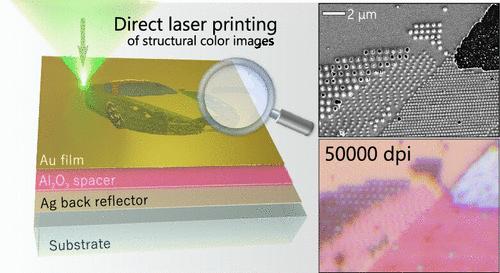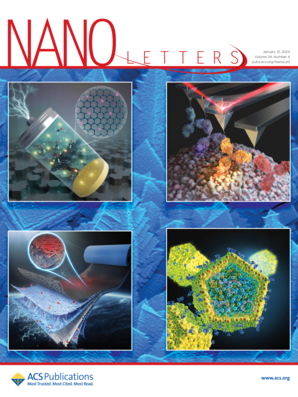Surface Coloring and Plasmonic Information Encryption at 50000 dpi Enabled by Direct Femtosecond Laser Printing
IF 9.6
1区 材料科学
Q1 CHEMISTRY, MULTIDISCIPLINARY
引用次数: 0
Abstract
Femtosecond (fs) laser pulses drive matter into a highly nonequilibrium state, allowing precise sculpturing of irradiated surface sites with sophisticated nanomorphologies. Here, we used fs-laser patterning to create diverse plasmonic morphologies on the top Au layer of the metal–insulator–metal sandwich. Mutual action of laser-driven thermomechanical effects and ultrafast solid-to-liquid transition allows control of the morphology resulting in pronounced surface reflectivity modulation, i.e., in a structural color effect. This enables template-free high-resolution color printing at a superior lateral resolution up to 50000 dots per inch and facile tunability of the color tone and saturation. Moreover, precise control over the orientation of the printed nanostructures within subwavelength lattices allows modulation of their local plasmonic response encrypting the optical information within the colorful images. The hidden information can be unveiled using a facile cross-polarized optical visualization scheme, rendering the proposed method with extra modalities combining high resolution information encryption, coloring, and security labeling.

通过直接飞秒激光打印实现 50000 dpi 的表面着色和等离子信息加密
飞秒(fs)激光脉冲可使物质进入高度非平衡状态,从而精确地雕刻出具有复杂纳米形态的照射表面。在这里,我们利用 fs 激光图案化技术在金属-绝缘体-金属夹层的顶部金层上创建了多种质子形态。激光驱动的热机械效应和超快固液转换的相互影响可以控制形态,从而产生明显的表面反射率调制,即结构色彩效应。这样就能实现无模板高分辨率彩色打印,横向分辨率高达 50000 点/英寸,并能方便地调节色调和饱和度。此外,通过精确控制亚波长晶格内印刷纳米结构的取向,可以调制其局部等离子响应,从而加密彩色图像中的光学信息。利用简单的交叉偏振光学可视化方案就能揭示隐藏的信息,从而使所提出的方法具有结合高分辨率信息加密、着色和安全标签的额外模式。
本文章由计算机程序翻译,如有差异,请以英文原文为准。
求助全文
约1分钟内获得全文
求助全文
来源期刊

Nano Letters
工程技术-材料科学:综合
CiteScore
16.80
自引率
2.80%
发文量
1182
审稿时长
1.4 months
期刊介绍:
Nano Letters serves as a dynamic platform for promptly disseminating original results in fundamental, applied, and emerging research across all facets of nanoscience and nanotechnology. A pivotal criterion for inclusion within Nano Letters is the convergence of at least two different areas or disciplines, ensuring a rich interdisciplinary scope. The journal is dedicated to fostering exploration in diverse areas, including:
- Experimental and theoretical findings on physical, chemical, and biological phenomena at the nanoscale
- Synthesis, characterization, and processing of organic, inorganic, polymer, and hybrid nanomaterials through physical, chemical, and biological methodologies
- Modeling and simulation of synthetic, assembly, and interaction processes
- Realization of integrated nanostructures and nano-engineered devices exhibiting advanced performance
- Applications of nanoscale materials in living and environmental systems
Nano Letters is committed to advancing and showcasing groundbreaking research that intersects various domains, fostering innovation and collaboration in the ever-evolving field of nanoscience and nanotechnology.
 求助内容:
求助内容: 应助结果提醒方式:
应助结果提醒方式:


